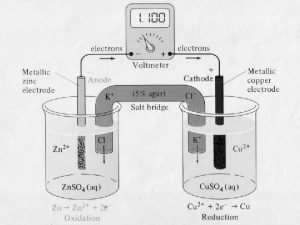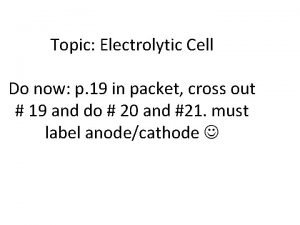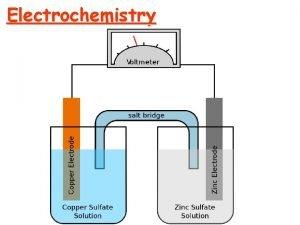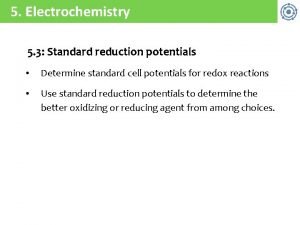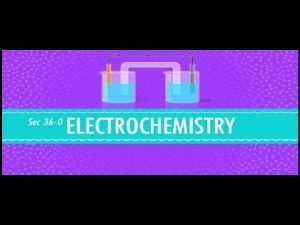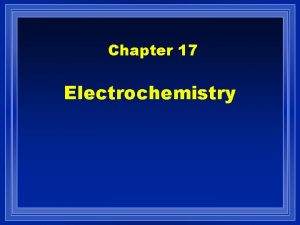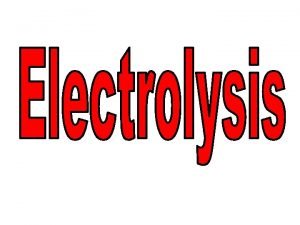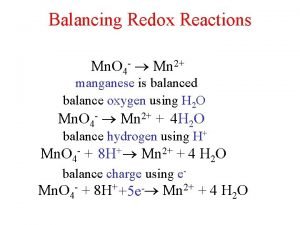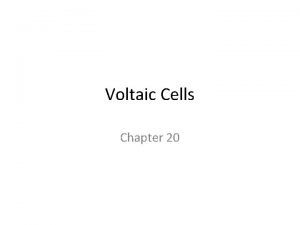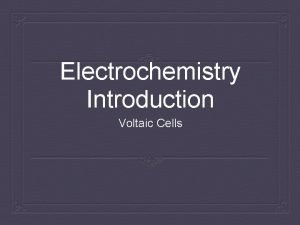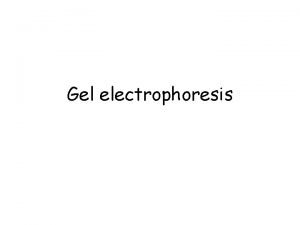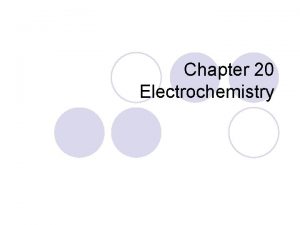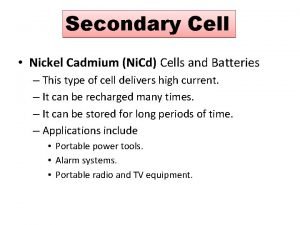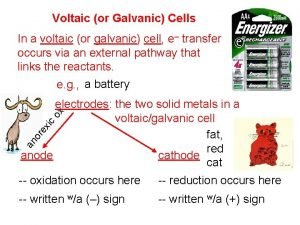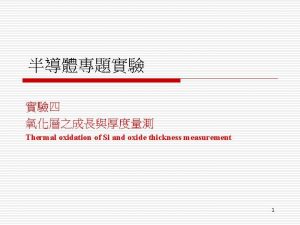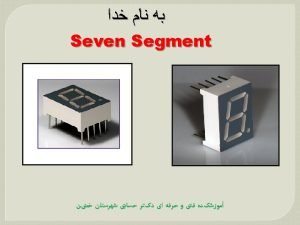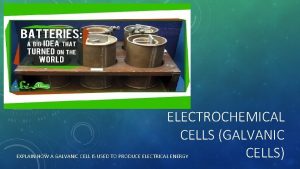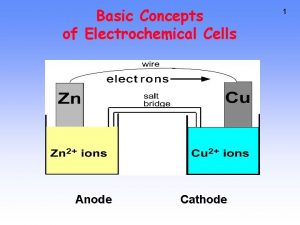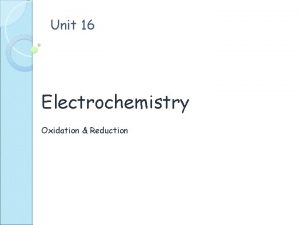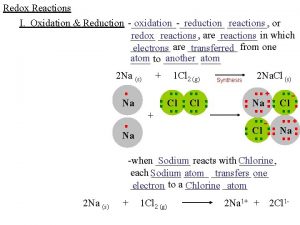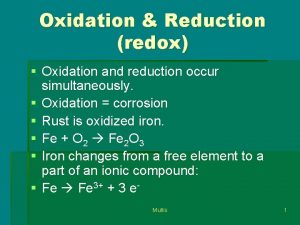1 Galvanic Cells anode oxidation cathode reduction spontaneous













![Now try: [Fe 2+] = 1. 0 M and [Cd 2+] = 0. 01 Now try: [Fe 2+] = 1. 0 M and [Cd 2+] = 0. 01](https://slidetodoc.com/presentation_image/375cd27d6dd48e938de62fa236f43990/image-14.jpg)









- Slides: 23

1

Galvanic Cells anode oxidation cathode reduction spontaneous redox reaction 2

Standard Reduction Potentials Zn (s) | Zn 2+ (1 M) || H+ (1 M) | H 2 (1 atm) | Pt (s) Anode (oxidation): Zn (s) Cathode (reduction): 2 e- + 2 H+ (1 M) Zn (s) + 2 H+ (1 M) Zn 2+ (1 M) + 2 e. H 2 (1 atm) Zn 2+ (1 M) + H 2 (1 atm) 3

Zn Cu 4

Brief Activity Series 5

6

7

• E 0 is for the reaction as written • The more positive E 0 the greater the tendency for the substance to be reduced • The half-cell reactions are reversible • The sign of E 0 changes when the reaction is reversed • Changing the stoichiometric coefficients of a half-cell reaction does not change the value of E 0 8

9

How many moles of Cu can be plated out of a solution containing Cu 2+ ions if a 1. 50 amp current is passed through for 300 s? Cu 2+ + 2 e- RXN: → Cu(s) Notes: 1 amp = C/s F = 9. 65 x 104 C/ mole e- Find: C → moles e-s 300 s 1. 50 C s → moles Cu mole e- 1 mole Cu 9. 65 x 104 C 2 mole e-s = 2. 33 x 10 -3 moles Cu 10

Effect of Concentration on EMF A Battery going dead. ∆G = ∆Go + RT ln. Q -n. FE = -n. FEo + RT ln Q Dividing by –n. F gives Rise to the Nerst Equation. 11

The Nerst Equation: Q: a. A + b. B ↔ c. C + d. D n = # of e- s transferred 12

The Nerst Equation allows us to find voltage under nonstandard conditions Example: Determine E (voltage) for: Fe(s) + Cd 2+(aq) → Fe 2+(aq) + Cd(s) When [Fe 2+] = 0. 10 M and [Cd 2+] = 1. 0 M @ 298 K Half RXNs: Fe(s) → Fe 2+ Cd 2+ + 2 e- → Cd(s) + 2 e- Eo = +0. 44 V Eo = -0. 40 V Eo = +0. 04 V + Value means spontaneous 13
![Now try Fe 2 1 0 M and Cd 2 0 01 Now try: [Fe 2+] = 1. 0 M and [Cd 2+] = 0. 01](https://slidetodoc.com/presentation_image/375cd27d6dd48e938de62fa236f43990/image-14.jpg)
Now try: [Fe 2+] = 1. 0 M and [Cd 2+] = 0. 01 M @ 298 K - Value means non spontaneous and will go in opposite direction 14

What does an E = 0 value mean? For: Fe(s) + Cd 2+(aq) → Fe 2+(aq) K = 22 + Cd(s) Eo = +0. 04 V 15

Concentration Cells Galvanic cell from two half-cells composed of the same material but differing in ion concentrations. 16

Batteries Lead storage battery Anode: Cathode: Pb (s) + SO 2 -4 (aq) Pb. SO 4 (s) + 2 e- Pb. O 2 (s) + 4 H+ (aq) + SO 24 (aq) + 2 e Pb (s) + Pb. O 2 (s) + 4 H+ (aq) + 2 SO 42 - (aq) Pb. SO 4 (s) + 2 H 2 O (l) 2 Pb. SO 4 (s) + 2 H 2 O (l) 17

Batteries Dry cell Leclanché cell Anode: Cathode: Zn (s) 2 NH 4+ (aq) + 2 Mn. O 2 (s) + 2 e- Zn (s) + 2 NH 4+ (aq) + 2 Mn. O 2 (s) Zn 2+ (aq) + 2 e. Mn 2 O 3 (s) + 2 NH 3 (aq) + H 2 O (l) Zn 2+ (aq) + 2 NH 3 (aq) + H 2 O (l) + Mn 2 O 3(s) 18

Batteries Mercury Battery Anode: Cathode: Zn(Hg) + 2 OH- (aq) Hg. O (s) + H 2 O (l) + 2 e. Zn(Hg) + Hg. O (s) Zn. O (s) + H 2 O (l) + 2 e. Hg (l) + 2 OH- (aq) Zn. O (s) + Hg (l) 19

Batteries Solid State Lithium Battery 20

Batteries A fuel cell is an electrochemical cell that requires a continuous supply of reactants to keep functioning Anode: Cathode: 2 H 2 (g) + 4 OH- (aq) O 2 (g) + 2 H 2 O (l) + 4 e 2 H 2 (g) + O 2 (g) 4 H 2 O (l) + 4 e 4 OH- (aq) 2 H 2 O (l) 21

Cathodic Protection of an Iron Storage Tank 22

Electrolysis is the process in which electrical energy is used to cause a nonspontaneous chemical reaction to occur. Electrolysis of molten Na. Cl 23
 What type of reaction is redox
What type of reaction is redox Galvanic cell cathode
Galvanic cell cathode Is the anode or cathode positive
Is the anode or cathode positive Oxidation and reduction in galvanic cells
Oxidation and reduction in galvanic cells Cell reaction in electrochemistry
Cell reaction in electrochemistry Cathode anode standard reduction potential
Cathode anode standard reduction potential Why are galvanic cells spontaneous
Why are galvanic cells spontaneous Galvanic cell cathode
Galvanic cell cathode Panic anode cathode
Panic anode cathode Cell reaction
Cell reaction Anode and cathode equation
Anode and cathode equation Cell chapter 20
Cell chapter 20 Balance redox
Balance redox What is the reaction at the anode in a breathalyzer?
What is the reaction at the anode in a breathalyzer? Common anode and common cathode
Common anode and common cathode Gel electrophoresis cathode anode
Gel electrophoresis cathode anode Chapter 20 electrochemistry
Chapter 20 electrochemistry Secondary cell nickel-cadmium
Secondary cell nickel-cadmium Electrons flow from cathode to anode
Electrons flow from cathode to anode How to remember anode and cathode
How to remember anode and cathode Anode cathode diode
Anode cathode diode Balancing redox reactions khan academy
Balancing redox reactions khan academy Voltaic and galvanic cells
Voltaic and galvanic cells Deal-grove model
Deal-grove model

